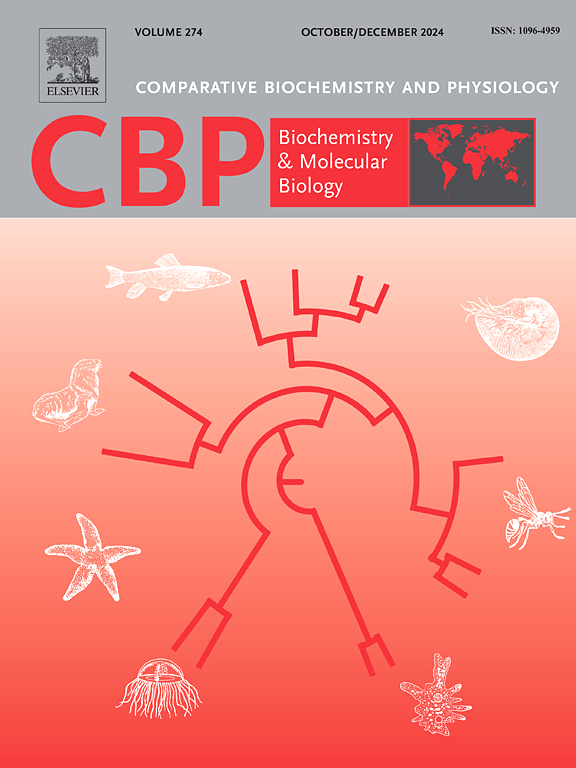Transfection with SV40 LT promotes oxidative damage in primary cultures of California sea lion muscle cells
IF 1.8
3区 生物学
Q4 BIOCHEMISTRY & MOLECULAR BIOLOGY
Comparative Biochemistry and Physiology B-Biochemistry & Molecular Biology
Pub Date : 2025-07-23
DOI:10.1016/j.cbpb.2025.111138
引用次数: 0
Abstract
Developing immortalized cell lines could significantly accelerate studies on marine mammal adaptations to breath-hold diving, ischemia/reperfusion cycles and oxidative stress. In this study, skeletal muscle-derived cells from California sea lions (Zalophus californianus) were transfected with simian virus 40 large T antigen (SV40 LT), a viral oncoprotein known to inactivate cell cycle regulators such as p53 and retinoblastoma (pRB). Although transfection and puromycin selection were successful, transfected cells exhibited morphological abnormalities and reduced viability, suggesting altered cellular proliferation pathways. Significantly higher superoxide dismutase (SOD) and glutathione S-transferase (GST) activities (2- and 6.1-fold, respectively), higher protein oxidative damage (3.9-fold), and lower catalase (CAT) activity (6.9-fold) were observed in transfected cells relative to control (untransfected) cells. These findings suggest that peroxide (H₂O₂) accumulation, likely triggered by genotoxic stress, disrupted cellular proliferation and/or cell death pathways in SV40 LT-transfected skeletal muscle-derived cells from California sea lions. Future studies should consider co-transfection with human telomerase reverse transcriptase (hTERT) and the use of lentiviral delivery systems to enhance transfection efficiency, reduce genotoxic effects, and improve culture stability. This study highlights current challenges and offers potential solutions for generating immortalized marine mammal cell lines.

转染SV40 LT促进加州海狮肌肉细胞原代培养的氧化损伤
开发永生化细胞系可以显著加快海洋哺乳动物对屏气潜水、缺血/再灌注周期和氧化应激的适应性研究。在这项研究中,将加利福尼亚海狮(Zalophus California)的骨骼肌来源细胞转染类人猿病毒40大T抗原(SV40 LT), SV40 LT是一种已知的病毒癌蛋白,可灭活细胞周期调节因子,如p53和视网膜母细胞瘤(pRB)。虽然转染和嘌呤霉素选择是成功的,但转染后的细胞表现出形态异常和活力降低,表明细胞增殖途径发生了改变。转染细胞的超氧化物歧化酶(SOD)和谷胱甘肽s -转移酶(GST)活性(分别为2-和6.1倍)、蛋白质氧化损伤(3.9倍)和过氧化氢酶(CAT)活性(6.9倍)显著高于对照(未转染)细胞。这些发现表明,过氧化氢(H₂O₂)积累,可能是由基因毒性应激引发的,破坏了来自加州海狮的SV40 rt转染的骨骼肌来源细胞的细胞增殖和/或细胞死亡途径。未来的研究应考虑与人类端粒酶逆转录酶(hTERT)共转染,并使用慢病毒传递系统来提高转染效率,减少基因毒性作用,提高培养稳定性。这项研究强调了当前的挑战,并为产生永生化海洋哺乳动物细胞系提供了潜在的解决方案。
本文章由计算机程序翻译,如有差异,请以英文原文为准。
求助全文
约1分钟内获得全文
求助全文
来源期刊
CiteScore
4.60
自引率
4.50%
发文量
77
审稿时长
22 days
期刊介绍:
Comparative Biochemistry & Physiology (CBP) publishes papers in comparative, environmental and evolutionary physiology.
Part B: Biochemical and Molecular Biology (CBPB), focuses on biochemical physiology, primarily bioenergetics/energy metabolism, cell biology, cellular stress responses, enzymology, intermediary metabolism, macromolecular structure and function, gene regulation, evolutionary genetics. Most studies focus on biochemical or molecular analyses that have clear ramifications for physiological processes.

 求助内容:
求助内容: 应助结果提醒方式:
应助结果提醒方式:


